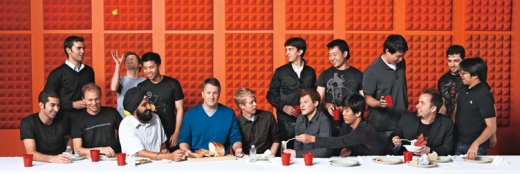
This is post #4 of the Inside the Accelerator series. To catch up with all of them, make sure to bookmark this link.
When you’re in the leadership position of an accelerator, it’s important to plan, and that’s exactly what Seed Hatchery’s Eric Mathews has done. Seed Hatchery, if you’re not familiar, is a seed-level accelerator based in Memphis, Tennessee. Having graduated its first class earlier this year, we’ve been following along as the accelerator prepares for cohort #2, set to launch in January of 2012.
So what has Mathews been planning? A big part of that is finding and polishing the things that could be seen as the core elements of Seed Hatchery. From office hours to training and informal meetings, each of these has earned a position of importance, so we’re going to take a look at what they are and why they’re held in high regard.
Office Hours
While the Seed Hatchery team obviously knows each of the companies and what they’re up to, it’s often difficult to keep things organized on a micro scale. With that in mind, Mathews tells me that each of the CEOs is required, once a week at least, to sit with the leadership and report on both progress and obstacles.
“These meetings enable our leadership team to stay abreast of the team’s progress while helping them anticipate challenges that they will face down the road in the program, based on the decisions that they make today.”
Mentor Meetings
Every other week, at least, teams are encouraged to have a meeting with their mentors. These people, who trade knowledge and time for a small stake in the company, are uniquely able to help the startups handle the challenges that come their way, but they can only do so if they know what’s going on.
Beyond the specific mentor meetings, though, it’s also encouraged that mentors are involved with board meetings for the companies. When you’re looking to bring focus and strategy to a team, especially amid so many things happening so close together, that outside voice of the mentor is invaluable.
Founders’ Dinners
I remember reading an Inc. article about Y Combinator, and being impressed with the idea of the entire group getting together to have a ‘family meal’. Not only was it a chance for the teams to get together and enjoy a few precious moments of “down time”, but I’d venture to say that it was also used as a brainstorming session where companies could talk about what was happening with one another.

- What happened in the previous 7 days
- What they’re planning for the upcoming 7 days
- What challenges or obstacles are they facing
It’s a chance to get some healthy peer pressure, where the teams are facing off with each other to see what’s happening inside the walls of work. But it’s also a chance to let the teams solve each other’s challenges and put to work that collective intelligence.
Training and Application
It should go without saying that one of the major parts of any accelerator is training the companies. Seed Hatchery is no different, according to Mathews.
Sprinkled through the program are information sessions. These sessions usually follow a particular training purpose and are immediately followed by trial applications of what the teams have just learned. You might remember, in the previous post of Inside the Accelerator, how we talked about the 3-week sections to which the accelerator is broken down. These training sessions are tailored to meet those sections, with workshops on customer discovery happening during the Discovery phase, for instance.
Informal Gatherings
One of the things that I’ve seen time and again with startups is their amazing ability to handle anything that they’ve practiced. But sometimes it’s important to inject a bit of random into the life of the company, according to Mathews. It’s with that in mind that informal gatherings and offsite experiences are planned.
“In short, these experiences introduce new perspectives to the founders on their startups, and it exposes them to new thinking – sparks of creativity and energy usually arise from these experiences.”
Pitch Practice
This final key element is something that I can’t wait to see — Pitch Practice. There’s nothing that’s more amazing, to me, than seeing someone stumble to express their idea on day 1, only to come out on Demo Day and absolutely wow the crowd. But you don’t get there by just learning more about your business. The game of pitching is like anything else — it requires practice.
Mathews tells me that, in the 9-week program, each team will have 10 dedicated sessions of pitch practice. It starts on week 1, with the teams eventually meeting with investors in order to “raise the stakes” of the moment. Not only do the investors benefit from an early look at the startups, but the startups themselves are given a healthy dose of the reality that their pitch is what can make or break a deal.
That does it for this edition of Inside the Accelerator. Next week, we’ll visit a couple of graduates from the first cohort to talk about what happened, where they are now and where they feel like business is taking them.
Get the TNW newsletter
Get the most important tech news in your inbox each week.





